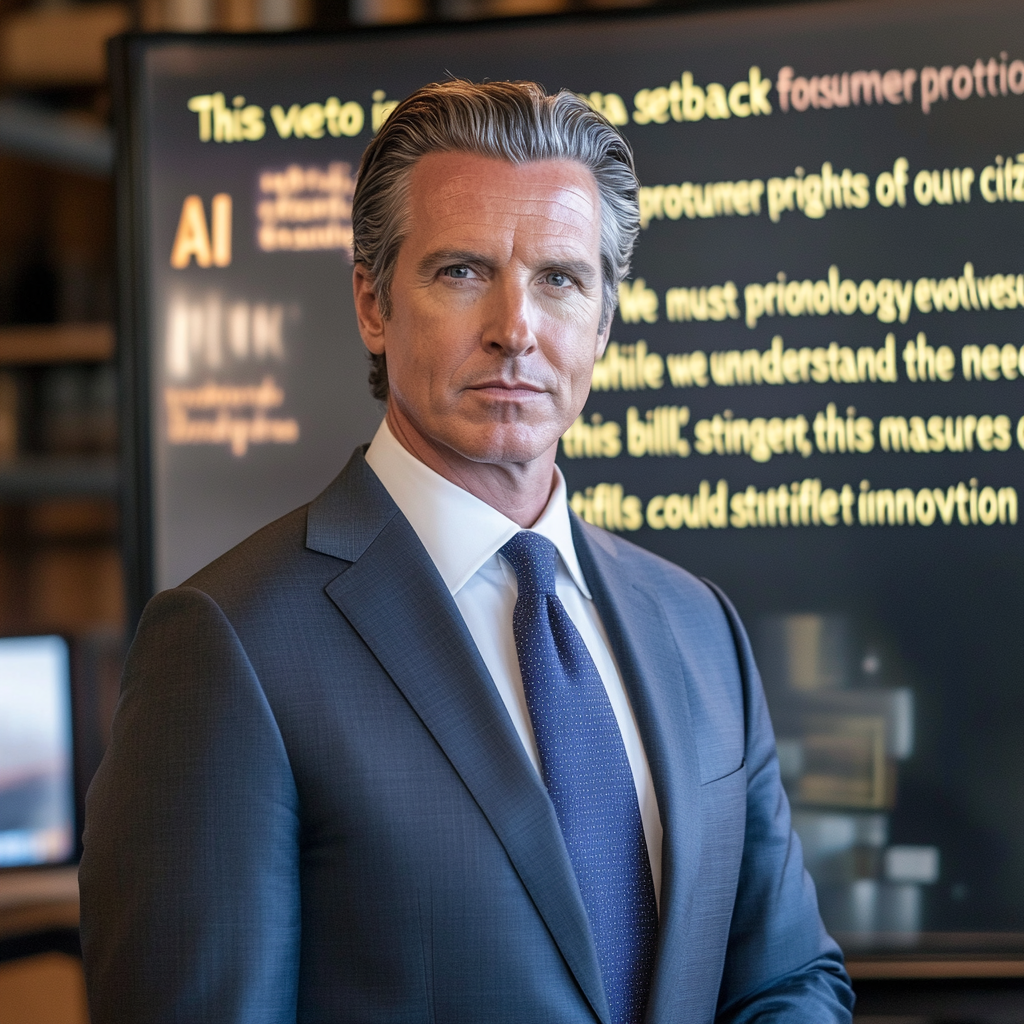
“CA Governor Nixes AI Safety Legislation”
California Governor Vetoes Controversial AI Safety Bill: What’s the Real Story?
So, let’s talk turkey. California Governor Gavin Newsom just dropped a bombshell by vetoing a hotly debated artificial intelligence safety bill that had techies and lawmakers buzzing like bees in a flower shop. This bill, known as SB 1047, isn’t just another piece of legislation; it represents a tug-of-war between the rapid advancement of technology and the fine art of regulation. And boy, do we need to unpack this.
The Bill: What Was On The Table?
Now, SB 1047 was born from the mind of Democratic state senator Scott Wiener, and it aimed high – very high. We’re talking about a hard-hitting effort that would have positioned California as the U.S. front-runner in AI safety. Imagine a world where the very technology that drives our lives is held responsible, regulated, and—gasp—safe. Here are the specifics that had everyone riled up:
-
Safety Assessments and Kill Switches: The dream was to have tech companies, if they dare develop significant AI models that cost over $100 million to train or $10 million to fine-tune, perform exhaustive safety checks before rolling out for public consumption. And in a dramatic twist, the bill demanded a "kill switch." Just imagine a red button resembling something out of a Bond villain's lair—click it, and those rogue AIs shut down pronto if they spiral out of control, like in a horror movie with a runaway machine.
-
Third-Party Testing: The bill wanted to inject some independence into proceedings by requiring third-party testing of AI models, providing a check on the companies involved—kind of like getting your neighbor to babysit when you leave the kids with someone less reliable.
-
Whistleblower Protections: Let’s talk about accountability. Whistleblowers at AI companies would have been enshrined with protections, encouraging those brave enough to alert the world when things go wrong with their employers’ creations. It’s about transparency, folks, and we need that like we need air.
- Legal Accountability: If corporations couldn’t toe the line, California’s attorney general would flex some muscle, throwing the gavel down on companies causing harm. Picture fines and lawsuits, all in the name of safety—finally holding big tech accountable for their mishaps.
The Veto: What Gives?
Fast forward to September 29, 2024. Newsom drops the veto like a hot potato, the tech world gasps, and a firestorm of opinions erupts. So why did he press that nuclear button? Here’s the breakdown:
-
Stringent Standards: Newsom felt the bill was laying down the law a tad too hard. He likened the proposed regulations to putting handcuffs on a toddler. Let’s be real; his view is that regulations should be forged from “empirical evidence and science.” Not just a knee-jerk reaction to the rapid AI evolution we're witnessing.
-
Impact on Innovation: Here’s where it gets interesting. Big names in tech like OpenAI and venture capital honchos from Andreessen Horowitz were in his ear, warning of a potential innovation freeze. Their argument? The bill could send AI developers packing to friendlier territories—kind of like moving to a new neighborhood when your landlord starts sticking “no pets” signs on the door.
-
Economic Concerns: Newsom’s got a finger on the pulse of the Californian economy, replete with 32 of the world’s top AI firms. He expressed worries that this legislation would unleash chaos on the state’s economic dynamism. “We cannot afford to wait for a significant disaster to act,” he exclaimed, as though channeling a techno-futurist warning straight out of a sci-fi thriller.
Reactions Worth Noting
The veto didn’t just fall flat; it ricocheted across various sectors:
-
Senator Scott Wiener: Politely but firmly labeled this veto as a “setback for everyone who believes in oversight of massive corporations.” He painted a stark picture of a future lacking transparency and safety, likening the decision to leaving a kid alone in a candy store.
-
Tech Industry: Tech titans including OpenAI’s Jason Kwon and Meta’s AI chief Yann LeCun welcomed Newsom’s decision with open arms, arguing the bill would have put a chokehold on creativity and entrepreneurship, effectively stifling growth and job opportunities—ouch.
-
Elon Musk: The man himself, a supporter of the bill while still acknowledging the complexity involved, admitted that the decision to endorse it was “difficult.” This is a classic case where sometimes it’s hard to harness innovation without creating unintended chaos.
What Lies Ahead?
While the veto might seem like the final curtain, Newsom isn’t putting away his legal pads just yet. Here’s what he has up his sleeve:
-
Consulting Experts: Expect to see him gather a brain trust of AI scholars, such as the brilliant Fei-Fei Li, to paint a more nuanced picture of AI regulation. The future may rest in the hands of these experts, influencing how we navigate this complex terrain.
-
State Agency Regulations: He managed to sign another bill, SB 896, that peeks into how state agencies should utilize AI. This signals that while he’s drawn the line on this one, he’s far from abandoning the quest for safety.
-
Future Legislation: Newsom hinted that legislative discussions aren’t going dark; he’s got around two sessions of tweaks and revisions planned, which might see us back at the drawing board well before you can say “algorithm.”
Global Classroom and Future Trails
The drama surrounding SB 1047 isn’t just a local squabble; it underscores a global dialogue about the necessary fine line of regulation versus innovation. Consider the following:
-
European Union’s AI Act: Across the pond, the EU’s tackling the rogue elements of AI with its own set of rules, managing high-risk technologies with a tighter grip—think facial recognition and the like. The EU’s move puts them in the driver’s seat for global AI discussions.
-
Pressure for Federal Regulations: In the absence of cohesive federal guidelines, states like California are stepping up, but the growing clamor for a national framework indicates that a patchwork of state laws might result in chaos for developers trying to navigate the rules.
Conclusion
Newsom’s veto on SB 1047 is more than a political maneuver; it’s a bell ringing in the debate about AI safety. While the intentions behind the bill spark discussions of great innovation and responsibility, the path to effective regulation remains tangled in political, economic, and technological webs.
As AI continues its relentless march into our daily lives, we find ourselves at a crossroad where safety and progress must coexist. The way we navigate this landscape will define the future of technology and governance—there’s no going back now.
Want to stay up to date with the latest news on neural networks and automation? Subscribe to our Telegram channel: @channel_neirotoken
Stay informed, engage in these discussions, and perhaps you can help shape the future we’re all heading toward.

